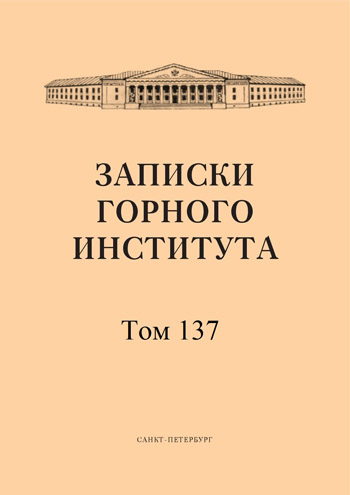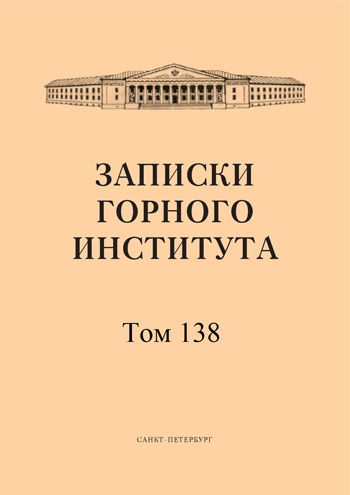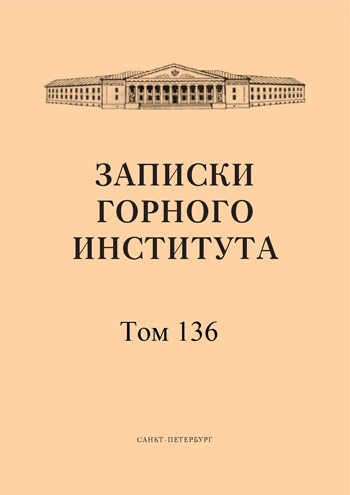-
Date submitted1992-08-06
-
Date accepted1992-10-06
-
Date published1993-12-06
Teaching of Geology of Mineral Deposits at the St. Petersburg Mining Institute (to the 90th anniversary of the department)
- Authors:
- Yu. V. Lir
- A. I. Pertel
The history of studying and teaching at the Mining Institute one of the basic disciplines - the doctrine of mineral deposits; the contribution of Russian scientists to the development of geological science is noted; the history of creation and development of the Department of Geology of Mineral Deposits is shown.
-
Date submitted1992-08-09
-
Date accepted1992-10-09
-
Date published1993-12-06
Models of endogenous deposits as a basis for preliminary assessment of new ore occurrences and ore-bearing areas
- Authors:
- A. D. Shcheglov
The issues of creation of ore deposit models for industrial evaluation of new ore occurrences identified during prospecting works are considered. The importance of their creation in connection with the new law "On Subsoil" regulating the sale of ore-bearing sites is emphasized. The main "components" of deposit models of applied value are outlined. Examples are given.
-
Date submitted1992-08-24
-
Date accepted1992-10-28
-
Date published1993-12-06
Principles of regional and local forecasting of skarn iron ore deposits of different formation types
- Authors:
- N. L. Shamanina
Skarn iron ore deposits are polyformational, so the regional regularities of their location are closely related to the evolution of their crustal structures. Local forecasting is determined primarily by the depth of deposit formation and their location within volcanoplutonic or metamorphic complexes.
-
Date submitted1992-08-02
-
Date accepted1992-10-23
-
Date published1993-12-06
Metal reserve structures as a consequence of genetic features of ore formation
- Authors:
- S. V. Sendek
The genetic informativeness of the structures of metal reserves of gold-bearing ores subjected to intramineralization metamorphic transformations is shown. By the nature of changes in reserve structures it is possible to judge about qualitative and quantitative features of ore-forming process.
-
Date submitted1992-08-28
-
Date accepted1992-10-01
-
Date published1993-12-06
Universal model of ore field structure as applied to gold deposits
- Authors:
- N. I. Mishin
- Z. A. Stepina
On the basis of the universal structural-geometric model of ore fields as regular correlated systems of ore-bearing disturbances, co-disjunctive to the main ore-controlling fault of shear type, the positions of a number of gold deposits of the North-East and Far East of Russia are considered
-
Date submitted1992-08-14
-
Date accepted1992-10-24
-
Date published1993-12-06
To the method of predicting the platinum content of rocks of the Fedorovo-Pan intrusion by the character of their organization
- Authors:
- Yu. L. Voitekhovsky
Based on the author's theoretical-multiple concept of a complex mineral aggregate, a statistical method of rock organization analysis is proposed. The lower entropy of the distributions of coordinations and different types of contacts of mineral grains in platinum-bearing gabbro-norites of the Fedorovo-Lansky intrusion indicates their higher structuring compared to their non-metallic analogs. This should be taken into account when identifying the most promising horizons in the monotonous section of the intrusive.
-
Date submitted1992-08-14
-
Date accepted1992-10-25
-
Date published1993-12-06
Vertical structural and morphological zoning of tin ore veins
- Authors:
- Yu. V. Lear
The theoretical model of vertical structural-morphological zonality is proposed, taking into account the peculiarities of its manifestation for each of the three selected morphological classes of veins. The existence of a regular relationship between the morphological parameters of veins at different levels of depth and their ore-bearing capacity at these levels was revealed.
-
Date submitted1992-08-27
-
Date accepted1992-10-25
-
Date published1993-12-06
Mineral composition of ores and formation type of the Karnabskoye tin deposit
- Authors:
- A. I. Pertel
30 typogenic ore minerals of the Karnabskoe deposit are described, including such rather rare ones as tellurocanfieldite, matildite, murgite, sternbergite, and menegneite. Arseno-pyrite-casserite and polysulfide stages of mineral formation have been identified. The Karnabskoe deposit is classified as a polyformational site.
-
Date submitted1992-08-05
-
Date accepted1992-10-19
-
Date published1993-12-06
Use of decryptometric survey in forecasting studies
- Authors:
- N. V. Nikitin
- D. V. Nikitin
Application of decryptometric survey for disassembling bearing rare-metal mineralization of granite massif of East Transbaikalia gave positive results. Two types of decryptograms are observed. The first one, with a distinct maximum in the temperature range of 300-550 °С, is characteristic for samples from steaming halos of unpromising Taptanai and Sakhanai massifs. The second, with distinct maxima at temperatures of 120; 250 and 400-600 °С, is characteristic of samples from the halos of the Dedonogorsky and Etykinsky massifs, which are associated with industrial rare-metal mineralization.
-
Date submitted1992-08-04
-
Date accepted1992-10-20
-
Date published1993-12-06
Fractal models and prospects for their use in geology
- Authors:
- S. S. Shakin
Deterministic, random and random-deterministic fractal mathematical models are described. Examples of geological objects and processes that can be described by such models are given. Methods of measuring fractal parameters are given.
-
Date submitted1992-08-04
-
Date accepted1992-10-12
-
Date published1993-12-06
On the discovery of lateral placers on the northeastern coast of Cuba
Prerequisites of heavy minerals concentration on the northeastern coast of Cuba are considered. The first positive results of prospecting works are covered.
-
Date submitted1992-08-07
-
Date accepted1992-10-28
-
Date published1993-12-06
Genetic framework of the metamorphogenic model of ore formation
- Authors:
- A. V. Kozlov
Taking as a basis for classification of endogenous deposits the form of heat-mass exchange between the Earth's crust and subcrustal zones, as well as between different levels within the ore-depositing zone, it is proposed to allocate metamorphogenic deposits into an independent group within the class of hydrothermal deposits. Control factors of metamorphogenic mineralization are considered
-
Date submitted1992-08-22
-
Date accepted1992-10-16
-
Date published1993-12-06
Fragmentary structure of petmatite veins and prediction of muscovite bearing capacity
- Authors:
- V. N. Morakhovsky
Examples of the most typical pegmatite veins of the North Baikal region, located in granitoid bodies and represented by combinations of converged different-structured zones, which have a rootless bar-shape of a certain spatial orientation of sizes, are considered. Prospective mica saturation is associated mainly with large-block (pegmatoid) zones, the separation of which from the "background" of other structures and the correct geometrization are of great practical importance.
-
Date submitted1992-08-30
-
Date accepted1992-10-25
-
Date published1993-12-06
Geological models of Donetsk coals formation (experience of system research)
- Authors:
- V. V. Kiryukov
- N. N. Ochkurov
Geological characterization of coal formation processes is given. The systems of coal formation including natural factors, which determine the properties and composition of fossil coals, are considered. The principle of classification of Donetsk coals on the basis of system approach is substantiated. The questions of discontinuous-continuous series of coal metamorphism are discussed and alternative models of formation of coals of different recoverability are offered, as well as the principles of selection of coal classification scales.
-
Date submitted1992-08-23
-
Date accepted1992-10-17
-
Date published1993-12-06
Analysis of shale oil shale potential in Russia and neighboring countries
- Authors:
- G. P. Dubar
On the basis of a large volume of materials the basic parameters of oil shale quality, prerequisites of oil shale accumulation, confinement to geostructures of oil shale formations, regularities of oil shale distribution in the area and in the section of basins, deposits, regions and possibilities of their complex utilization are given.


